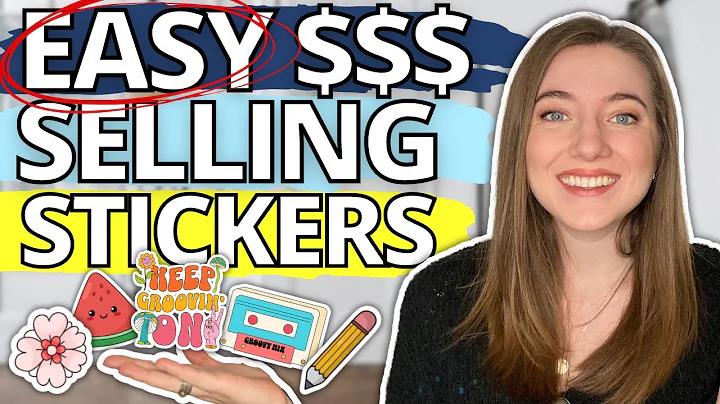From £30 to £33000 on eBay!
Table of Contents
- Introduction
- Getting Started in E-commerce
- Starting with Limited Funds
- Finding Product Ideas
- Researching Best-Selling Products
- Using Amazon Best Sellers
- Exploring Different Categories
- Finding Suppliers
- Understanding dropshipping
- Using AliExpress and Alibaba
- Evaluating Suppliers on Price and Quality
- Assessing Delivery Options
- Pricing and Profit Margins
- Calculating Costs and Expenses
- Determining Selling Price
- Offering Free Shipping
- Considerations for Dropshipping
- Listing Products on eBay
- Creating Compelling Product Descriptions
- Optimizing Keywords for SEO
- Taking High-Quality Product Photos
- Writing Attractive Titles and Headings
- Managing Orders and Shipping
- Dealing with Packaging and Shipping
- Handling Returns and Customer Service
- Automating Order Fulfillment
- Scaling Your E-commerce Business
- Increasing Inventory and Product Range
- Utilizing Customer Feedback and Reviews
- Expanding into Other Marketplaces
- Building Your Own E-commerce Store
- Conclusion
How to Start a Profitable E-commerce Business on eBay
Note: This article is based on personal experiences and proven strategies for starting a successful e-commerce business on eBay. It provides practical steps and tips for beginners who want to venture into the world of online selling with limited resources.
Introduction
Back in 2012, when I started selling on eBay and Amazon, I had no prior knowledge or significant financial resources. As someone working a minimum-wage job, I could only afford to invest as little as £30 in inventory from China. In this guide, I will share my journey and provide you with implementable steps to kickstart your own e-commerce business without breaking the bank.
Getting Started in E-commerce
Starting with Limited Funds
Starting an e-commerce business doesn't necessarily require a large upfront investment. You can begin by identifying low-cost products and testing the market demand. This approach allows you to gain experience, generate profit, and reinvest in your business.
Finding Product Ideas
To find product ideas, start by exploring Amazon's Best Sellers list. This resource showcases various categories and provides insight into trending items with high demand. Alternatively, you can choose a category of personal interest or passion and research specific products within that niche.
Researching Best-Selling Products
Once you have identified a potential product, research its marketability and competition. Compare prices and customer reviews on both Amazon and eBay to gauge the sales potential. Look for gaps in the market or unique selling points that will give you a competitive advantage.
Using Amazon Best Sellers
Amazon's Best Sellers list offers a wealth of information on top-performing products. Explore different categories within the list to identify items that align with your interests and have a high sales volume. Take note of product features, customer reviews, and pricing to understand the market landscape.
Exploring Different Categories
Don't limit yourself to one specific category. Explore different product categories and assess their potential profitability. Consider factors such as market demand, competition, and your own expertise or interest in the particular niche.
Finding Suppliers
Understanding Dropshipping
One efficient way to start an e-commerce business without inventory is through dropshipping. This method involves partnering with suppliers who handle product storage, packaging, and shipping directly to customers. Platforms like AliExpress and Alibaba are popular for finding dropshipping suppliers.
Using AliExpress and Alibaba
AliExpress is a retail platform where you can find a wide range of products at affordable prices. It is a great resource for beginners to source products for dropshipping. Alibaba, on the other hand, is a wholesale marketplace where you can find manufacturers and suppliers in bulk quantities.
Evaluating Suppliers on Price and Quality
When selecting suppliers, consider factors such as product quality, pricing, shipping options, and reliability. Contact suppliers directly to negotiate prices, shipping terms, and any discounts for larger quantities. Always aim for a balance between quality and affordability to ensure customer satisfaction.
Assessing Delivery Options
Consider the delivery options offered by suppliers, especially if you want to provide faster shipping to your customers. Look for suppliers who offer expedited shipping services and factor in any additional costs while calculating your selling price.
Pricing and Profit Margins
Calculating Costs and Expenses
Before determining your selling price, calculate all costs associated with the product, including the purchase price, shipping fees, taxes, and packaging materials. It is essential to have a clear understanding of your expenses to set a competitive yet profitable selling price.
Determining Selling Price
When setting your selling price, consider the prices offered by competitors on platforms like eBay. Price your products competitively, but also ensure that you maintain reasonable profit margins. Offering free shipping can attract more customers, but remember to account for shipping costs in your calculations.
Offering Free Shipping
To entice customers and increase sales, consider offering free shipping. While the shipping cost is absorbed by you, the perceived value and convenience can make your products more appealing. However, factor in the shipping costs when calculating your profit margins.
Considerations for Dropshipping
If you choose dropshipping, combining multiple items into a bundle can help increase the perceived value for customers. By offering bundled products, you can maintain a competitive price while still benefiting from higher profit margins. Focus on creating a positive customer experience to encourage repeat sales.
Listing Products on eBay
Creating Compelling Product Descriptions
When listing your products on eBay, write compelling and informative descriptions that highlight the product's features and benefits. Use persuasive language and address potential customer concerns to increase trust and drive sales. Optimize your descriptions with relevant keywords for improved search engine visibility.
Optimizing Keywords for SEO
To improve your product's visibility on eBay, utilize search engine optimization techniques. Conduct keyword research using tools like eBay's search bar, Google Trends, and keyword research tools. Incorporate relevant keywords in your titles, descriptions, and item specifics to increase the chances of appearing in search results.
Taking High-Quality Product Photos
High-quality product photos are crucial to attract potential buyers. Invest in good lighting and use a neutral background to showcase your products clearly. Include multiple images from different angles to provide a comprehensive view of the product. Ensure images accurately represent the item's condition.
Writing Attractive Titles and Headings
Craft attention-grabbing titles that accurately describe your product and its key selling points. Use persuasive language and incorporate relevant keywords to improve search visibility. Organize your listings using headings and bullet points to make information easily digestible for potential buyers.
Managing Orders and Shipping
Dealing with Packaging and Shipping
As a seller, you are responsible for packaging items securely and shipping them to customers on time. Utilize appropriate packaging materials to protect the products during transit. Consider investing in tools and resources that help streamline your packaging process, such as label printers and shipping software.
Handling Returns and Customer Service
Establish clear return policies and communicate them effectively to your customers. Be prepared to handle customer inquiries promptly and professionally. Providing exceptional customer service can lead to positive feedback and increased customer loyalty.
Automating Order Fulfillment
As your business grows, consider automating your order fulfillment process to save time and improve efficiency. Utilize third-party software and platforms that integrate with your e-commerce store to streamline order processing and shipping. Automation can help you scale your business without overwhelming manual efforts.
Scaling Your E-commerce Business
Increasing Inventory and Product Range
Once you have established a successful product line, consider expanding your inventory and introducing related products. Keep a close eye on market trends and customer preferences to offer a diverse range of items. Continuously research and test new products to stay competitive.
Utilizing Customer Feedback and Reviews
Pay close attention to customer feedback and reviews to gain valuable insights. Address any negative feedback promptly and use it to improve your products and customer service. Positive reviews can help build credibility and attract new customers. Encourage satisfied customers to leave feedback and ratings.
Expanding into Other Marketplaces
While eBay is a popular and reliable platform, consider expanding your sales channels by selling on other marketplaces like Amazon, Etsy, or your own e-commerce website. Diversifying your channels can increase your reach and customer base.
Building Your Own E-commerce Store
As your business grows, consider developing your own e-commerce store. Building your own website allows for greater control over branding, customer experience, and profit margins. It also allows you to direct traffic and build a loyal customer base independently.
Conclusion
Starting a profitable e-commerce business on eBay is achievable with the right strategies and mindset. By conducting thorough research, finding reliable suppliers, determining competitive pricing, creating compelling listings, and providing exceptional customer service, you can build a successful online business. Continuously adapt to market trends, implement feedback, and embrace growth opportunities to scale your business and achieve long-term success.
Highlights
- Starting an e-commerce business on eBay with limited funds is possible by finding affordable products and testing the market.
- Utilize platforms like Amazon's Best Sellers and eBay for product research and identifying profitable items with high demand.
- Dropshipping through AliExpress and Alibaba allows you to sell products without inventory and handle shipping and packaging.
- Calculate all costs and expenses to determine your pricing and profit margins. Offering free shipping can attract more customers.
- Optimize your eBay listings with compelling product descriptions, relevant keywords, and high-quality product photos.
- Efficiently manage orders and shipping by using suitable packaging materials, establishing clear return policies, and considering automation.
- Scale your e-commerce business by expanding your inventory, utilizing customer feedback, and exploring other marketplaces.
- Consider building your own e-commerce store for greater control over branding, customer experience, and profit margins.
FAQ
Q: How much money do I need to start an e-commerce business on eBay?
A: You can start with as little as £30 by sourcing low-cost products from platforms like AliExpress and Alibaba.
Q: Can I sell products on eBay without inventory?
A: Yes, you can utilize dropshipping by partnering with suppliers who handle storage, packaging, and shipping.
Q: How do I find profitable products to sell on eBay?
A: Conduct market research, explore Amazon's Best Sellers list, and compare prices and demand on eBay to identify profitable items.
Q: Can I offer free shipping to attract more customers?
A: Yes, offering free shipping can be an effective strategy to increase sales and attract potential buyers.
Q: How do I handle customer returns and provide exceptional customer service?
A: Establish clear return policies, promptly address customer inquiries, and prioritize providing excellent customer service.
Q: How can I scale my e-commerce business on eBay?
A: Scale your business by expanding your inventory, utilizing customer feedback, exploring other marketplaces, and considering building your own e-commerce store.















